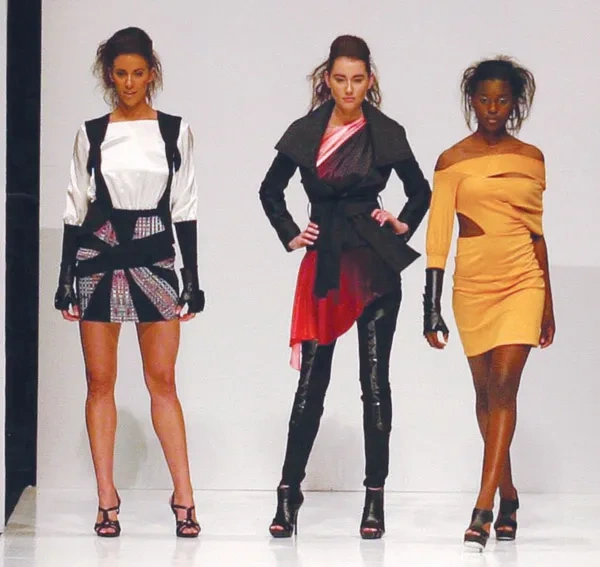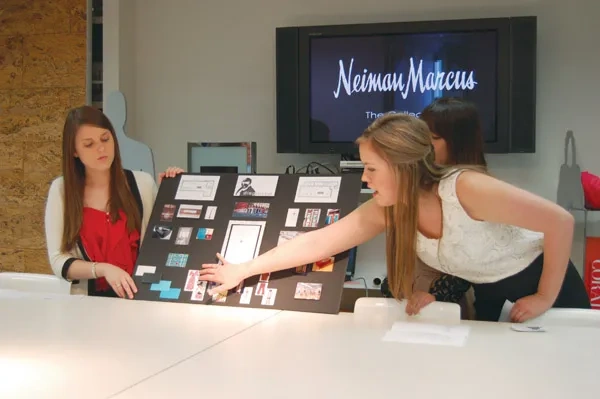From Ranch to Runway
UT's Textiles and Apparel program has grown 1,000 percent in the past 15 years. Through its fashion show and UT in NYC dream course, the program is launching grads to dizzying heights in the world's fourth-largest industry.

Designers hover over sewing machines, pins pinched between their lips as they meticulously feed material through. Others kneel before mannequins that wear half-completed knit-fabric garments, tugging to ensure a perfect fit.
It’s both organized chaos and an all-out sprint against the clock. Their clothing must be completed by morning, and their time in the lab ends soon. And then the UT Tower chimes.
No, this isn’t Project Runway. There’s no Heidi Klum, Michael Kors, or Nina Garcia. For the students of UT’s Textiles and Apparel program, it’s more of a burnt-orange runway—though their ambitions reach far beyond the Forty Acres.
And they have a reason to dream big. Coca-Cola’s global licensing manager, Christian Dior’s merchandising VP, and Academy Sports and Outdoor’s apparel VP, among many others, all graduated from UT with a Textiles and Apparel degree. Illustrious careers seem to have become a package deal with a diploma from the School of Human Ecology.
“The strength of a program like Textiles and Apparel is in the remarkably committed—and talented—people,” says Sheldon Ekland-Olson, the school’s director. “Talent trumps everything, and the Textiles and Apparel program has talent to spare.”
The School of Human Ecology is part of the College of Natural Sciences, the second-largest college at UT. The school is new—it officially became a school in 2010—and has its roots in the home economics program of UT past.
But it isn’t the past that sets apart the School of Human Ecology and the Textiles and Apparel program, which offers concentrations in apparel design, conservation, and retail merchandising—it’s the present.
“When I started work here in 1996, there were nine or 10 Textiles and Apparel majors,” says Eve Nicols, director of the fashion design program. “Now there are 97 majors. It’s time to let someone know we are here.”
That 1,111 percent increase in TXA students is a testament to the program’s rising-star status. By creating connections both on the home front, in New York City, and internationally over the last 15 years, TXA now operates at a level rivaling companies that send looks down the runway in Milan and Paris—and the proof is in its own fashion show.
The Show

Each year, UT’s fashion show showcases the designs of senior TXA students to the University community and Austin fashion scene. During Nicols’ first year as director in 1997, 500 people attended the show, which was held in the Lone Star Room in the Frank Erwin Center. By the 2011 show, Innovation, the audience had grown to more than 5,000, and the runway was moved to the Erwin Center arena.
“We want to operate at a professional level and a level that’s appropriate to UT’s expectations,” Nicols says. “Our students are not at all fazed by the variables of professional experience anymore.”
It helps to have professional models, hair stylists, and makeup artists to work with during runway preparation—something students 15 years ago didn’t have. Before George Mitchell of the University Co-op stepped in to sponsor the event, other students and even the designers modeled their own garments.
Thanks to events of this caliber, it is now the norm for Textiles and Apparel majors to graduate with promising careers at fashion powerhouses like Fossil, Betsey Johnson, and Abercrombie & Fitch.
“I attribute my success to my overall experience there,” says Destiny Flores, BS ’00, Life Member, former Neiman Marcus art director and now JCPenney’s styling director. “The professors and classes I had still play a role in my day-to-day life. I still bring up things from my History of Fashion course in random conversation.”
Other TXA graduates take advantage of the program’s required business coursework to start their own companies, as did Lauren Polt, BS ’05.
Polt already launched her own tailgate-wear line, Chicka-d—and she’s just six years out of college. With 62 college and pro team licenses, the Austin-based Chicka-d specializes in fashionable gameday dresses for sports teams all over the country.
“I had the idea at UT tailgates and football games in 2002. There just wasn’t a lot of stuff that was cute and trendy,” Polt says. “I knew I wanted to start this company, but I had to get real-world experience first.”
So Polt headed to the style mecca of the United States, New York City, to get her feet wet in fashion. It’s the kind of move that the Textiles and Apparel program is increasingly supporting as it creates one-of-a-kind programs that connect homegrown Texans with the design world of the Big Apple.
UT in NYC

The idea for a weeklong TXA student trip to New York City sparked from a conversation between then-Natural Sciences dean Mary Ann Rankin and Nancy Prideaux, BS ’81, director of the retail merchandising track. They discussed the need to build a bridge between Austin and the fashionistas of New York, enabling students to obtain more internships and jobs in the Northeast.
“The School of Human Ecology is such a nurturing place; it treats each person as an individual,” Prideaux says. “We wanted to maximize that student experience.”
To do that, the pair brought in the expertise of New York style icon Iris Apfel (see page 40), a visiting professor at UT who has 70 years of connections in the fashion industry. In just four months, Apfel had booked the likes of Harold Koda of the Metropolitan Museum of Art, Linda Fargo of Bergdorf Goodman, and Kenneth Wyse of Phillips-Van Heusen to meet with students on the May trip.
Back at UT, Prideaux, the newly named director of the UT in NYC program, struggled to pick 14 junior and senior students from the qualified stack of 27 applications she received for the pilot venture.
The goal: to provide students, who tend to see fashion primarily in terms of design, with a macro look at all the possible careers in the world’s fourth-largest industry. The gray areas—jobs outside of simply being a designer or retail-company buyer—were just as important to the NYC trip, if not more so. According to Prideaux, some of TXA’s most successful alumni have found careers in fields like journalism, public relations, and marketing.
To emphasize the importance of an open mind, Prideaux devised a plan to team up seven merchandising majors with seven design majors, and she made sure they were prepared to impress. During prep classes in the spring, the teams developed questions for each company they would visit that were then approved by Prideaux. The move paid off.
“Iris went with Kenneth Wyse [of Phillips-Van Heusen] to get her coat, and I overheard him telling her, ‘They are really smart, Iris. They ask great questions,’” Prideaux says.
During their time in New York, the TXA students visited the boardrooms of fashion luminaries at companies like MAC Cosmetics, W Magazine, and HSN. The speakers didn’t simply lecture with PowerPoint slides; they gave tours of their factories, got coffee together, and talked one-on-one with UT in NYC participants.
“Through this program, the students get to learn from industry leaders that other industry leaders don’t even have access to,” Prideaux says. “There’s such a joy in opening doors that top-level executives can’t even get into.”
The Support

Programs like UT in NYC wouldn’t be possible without the support of passionate TXA alumni. Their loyalty is evidenced by the actions of home economics alum Barbara Wofford, BS ’54, whose donation was instrumental in the school’s evolution from a department in 2010.
“I asked which of the programs wasn’t getting funding, which one was getting overlooked,” Wofford says, “so I donated to the Textiles and Apparel program.”
Overlooked no more: with donations like Wofford’s, TXA has purchased new sewing machines, enabling the students to work with more complicated fabrics, like knits. Wofford also delivers fabric to design classes, filling her car with material.
And Wofford is just one of the many alumni supporting the TXA cause and School of Human Ecology cause. The Besings of Dallas—Tricia, BS ’86, and Gil, BBA ’83, Life Members—gave the initial gift that allowed UT in NYC to be established. The school is now raising funds to endow the program. It also established the Iris Barrel Apfel Endowment for the Historical Textiles and Apparel Collection.
In addition, the Texas Exes New York Chapter hosts a NYC Seminar each March that offers networking opportunities to UT students in advertising, public relations, journalism, and arts administration. In 2011, the New York Exes added a Textiles and Apparel track; for many of the students who aren’t able to take UT in NYC, the NYC Seminar exposes them to the city and helps them make connections.
The Textiles and Apparel program’s growth—and the hard work and generosity surrounding it—testify to the way it gives its students the best possible head start in a cutthroat industry. From a successful Austin fashion show to rapidly expanding New York trips, TXA can go nowhere but up.
“We’re doing it quietly,” Prideaux says, “but we’re doing it well. We’re doing it because the apparel industry is never going away—it’s an important piece of the fabric of our world.”
Photos courtesy the School of Human Ecology





